Ultrabook Head to Head: Acer Aspire S3 vs. ASUS UX31E
by Jarred Walton & Manveer Wasson on December 21, 2011 5:40 AM ESTNetbook Levels of Battery Life
When netbooks came on the scene, they made the idea of a $1000+ ultraportable seem rather laughable. Several years later we’re rebranding ultraportables as ultrabooks (provided they have Intel Inside) and giving it another go. Of course, ultrabooks pack a few tricks like SSDs for better battery life and performance, and Intel’s ULV Sandy Bridge processors are proving to be very efficient when it comes to saving power. We ran our usual suite of battery life tests, with the LCDs set to as close to 100 nits as possible (50% brightness on the Acer S3 and 18% brightness on the ASUS UX31E).
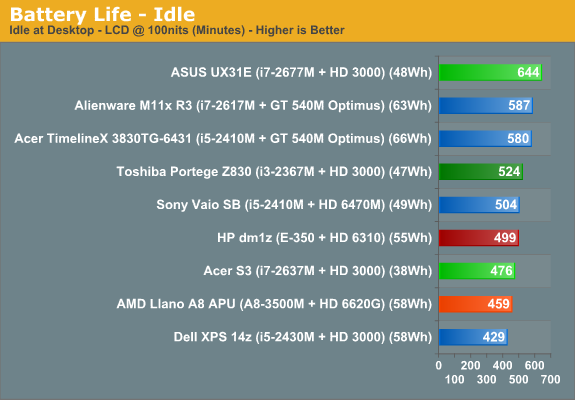
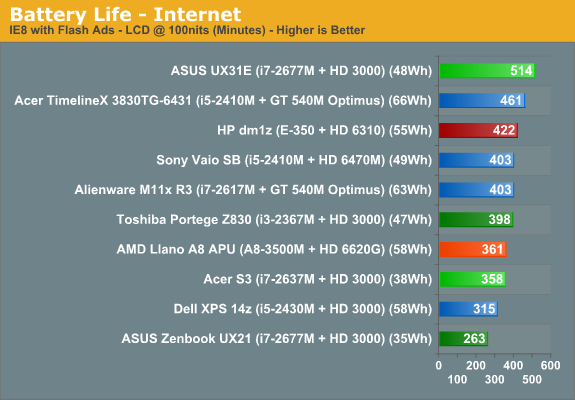
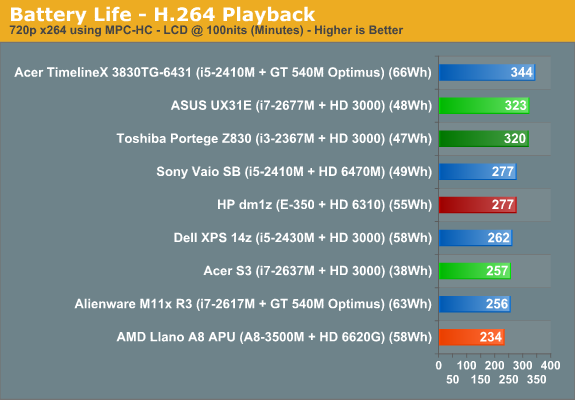
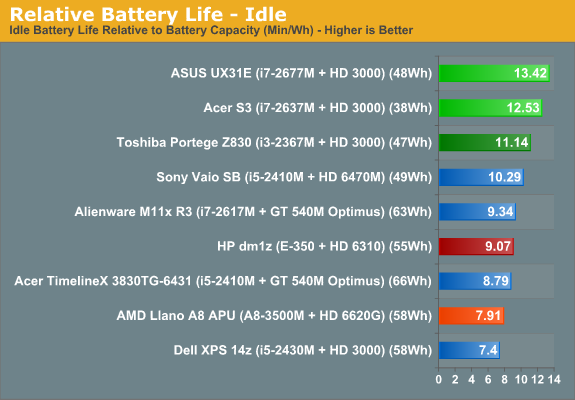
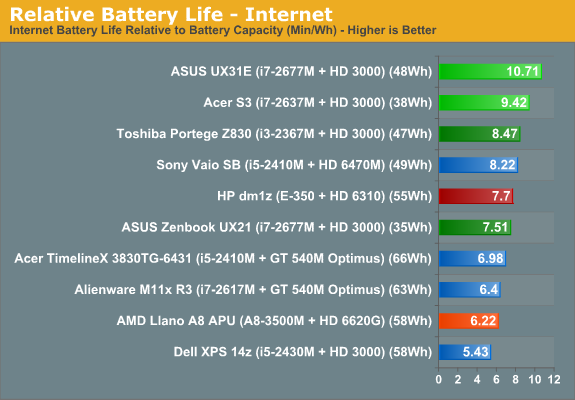

The Acer has a much smaller 3-cell battery, but even with a 38Wh capacity it still boasts respectable battery life of over four hours of H.264 playback and nearly eight hours of idle time. Switch over to the UX31E and not only do you get a higher battery capacity, you also get apparently better power optimizations. In our H.264 test the ASUS “only” manages close to 5.5 hours of playback, while it jumps to 8.5 hours of Internet surfing and over 10.5 hours of idle time. Look at the relative battery life charts and the results are even more impressive: the three ultrabooks we’ve reviewed place at the top of the charts, and even if we compare with Atom, the UX31E matches and sometimes exceeds what the best netbooks could achieve; the other two ultrabooks where we’ve done full reviews also place near the top of our relative battery life charts.
Something else we tested that we don’t have in the above charts is idle battery life with the LCD at maximum brightness. The Acer drops to 400 minutes, but then it only gets about 120% brighter as we’ll see on the next page. The UX31E on the other hand does a swan dive down to just 357 minutes, but you have to take into consideration the 450% increase in brightness. Put another way, power draw for the Acer is around 4.7W at 107 nits (50%) and 5.59W at 234 nits (100%); the ASUS on the other hand uses 4.38W at 93 nits (18%) and jumps up to 7.91W at 519 nits (100%). Even though that’s a pretty big jump in power use, we still have to credit the LED backlighting technology: 500+ nits for less than 5W of power isn’t really that bad.
The short summary here is that you may have to pay more, but you do get substantially better performance than a netbook, you don’t sacrifice much in the size or battery life departments, and build quality is generally far higher than inexpensive laptops and netbooks. Does that make ultrabooks a better option than other laptops? Not for everyone, but there are certainly people that will like what ultrabooks have to offer.










81 Comments
View All Comments
Hector2 - Wednesday, December 21, 2011 - link
I think Intel has it right with the move to Ultrabooks, but these early SandyBridge-based models without Touch aren't what I'm looking for --- though much better than the old non-Ultrabook form factor.I'll get my Win 8 Ultrabook when there's one with a nice medium size, Touch screen model with Ivy Bridge inside, that has only an external wireless keyboard (no physical keyboard buttons on the UB itself), with wireless mouse and a Thunderbolt or Lightpeak connection for an external Monitor, when desired.
This would serve as a nice, portable Touch tablet when I'm mobile but also able to use as a full blown i7 Core PC workstation for work plugged into nice keyboard, nice mouse and my 24" LCD monitor
It'll happen. Just a question now of when
Paedric - Wednesday, December 21, 2011 - link
Ivy Bridge really seems interesting, as it combines reduced power consumption with better integrated graphics.I think the CPU is already powerful enough for what it has to do, with only graphics lacking.
It will also be the second generation of ultrabooks, so a lot of "newbie" errors should be fixed.
I'm not sold on Win 8 and touch though.
I think it's the role of tablet to be able to change to notebook, not the other way around, the Asus Transformer is the perfect example of this.
Nexing - Wednesday, December 28, 2011 - link
Plenty of people wants to have a powerful, portable, battery lasting -at least for daily duties-, price competitive... sleek laptop.These ultrabooks do come close, except for the terrible omission of Intel's "Ivy bridge" 22nm CPU, which means that whatever CPU this ultrabook, (or any other released up to May 2012) comes with... will bear the almost obsolete 32nm "Sandy Bridge" CPU technology. Which means that this whole early ultrabook generation will not be battery efficient enough(4 hrs vs Ivy's 8-10 hrs of real usage, or will not run cool enough (not to be used at bed, on a coach, on your legs, etc).
Very different story to the REALLY new ultrabook laptops to be released somewhen after 2012 Q2 that will come with Ivy Bridge CPUs...
And to worse matters, those who actually buy one of these pre-Ivy Bridge Ubooks will never be able to upgrade into the coming 22nm tech, just because Intel said so (it is technically feasible and the norm for actually , confirmed to be upgradeable Sandy Bridge desktops)... So good luck with the niche & soon-to-be-obsolete 2011/Q1 2012 Ubooks,
BUYERS BEWARE!!!
seapeople - Saturday, January 14, 2012 - link
First of all, there is no Ivy Bridge, and if you want a computer within the next ~HALF YEAR then you'll have to buy one with poor old inefficient Sandy Bridge.Second of all, there's no way Ivy Bridge is going to increase battery life by 2.5x over Sandy Bridge. Just because it's a new architecture does not mean it will blow us away; Arrandale ULV laptops gave almost no benefit over Core 2 Duo ULV in terms of battery life, and actually decreased battery life in many cases (albeit with a fair performance increase, but not mind blowing).
Third, if you think current Ultrabooks with Optimus and/or integrated graphics run too hot to be used on your lap, you are insane.
Pessimism - Wednesday, December 21, 2011 - link
I'd suggest adding the MBA display data to your graphs since you heavily compare these systems to it and complain about the overall lack of display quality. Since Joe Public thinks Apple products can do no wrong and are made out of unicorn horns and fairy dust, lets see some hard data.JarredWalton - Wednesday, December 21, 2011 - link
Added. Obviously we don't have the performance results for the MBA on most tests, but the LCD results are at least something we can easily compare.Pessimism - Thursday, December 22, 2011 - link
Thanks! Hopefully with enough direct numeric comparisons in reviews we can convince PC makers to stop using horrible, horrible panels.Deelron - Wednesday, December 21, 2011 - link
Occasionally Joe Public isn't wrong.UrQuan3 - Wednesday, December 21, 2011 - link
"but seriously: first IPS panel in a 13.3” laptop for under $1000 gets an Editor’s Choice award (as long as the rest of the laptop doesn’t completely suck)."That might be my favorite quote from this site. I hope some vendors are reading. I've been wanting and sRGB under 14" laptop for a decade. Settled for a Samsung 9 for now. Far from perfect, but it'll do for now.
jasondunn - Wednesday, December 21, 2011 - link
I purchased a UX31 in October. I wanted it so badly I paid $68 to get next-day shipping because I was traveling and wanted it before I left. There are many things that are excellent about the UX31: I was impressed with the screen, the performance, the speed of sleep resume and boot, etc. But there's a *giant* problem with this laptop: the keyboard requires a heavy-handed style of typing. I type quite quickly, and apparently I type too "light" for the UX31.I've owned and used well over a dozen different laptops over the past decade, and the UX31 is the first where I found typing to be a disaster. I don't use that word lightly: I'd venture that 25% of all keystrokes were dropped. That means every single word I typed longer than a few characters would have errors it it. I contacted Asus support, they had me install a software update, and nothing changed. I went to a local Microsoft store and used the UX31 display model...it had exactly the same problem. If I slowed down and typed with more force, I got 100% accuracy. I don't believe I had a defective UX31 - I think this is simply the awful keyboard that Asus put in it.
I should add that I found Asus' tech support to be quite lacking and would be very wary of dealing with them again.
So my advice is this: make sure you're able to test the keyboard in person before putting down $1000+ to buy it. I regret my purchase and had to settle for a $1349 in-store credit rather than getting my money back.